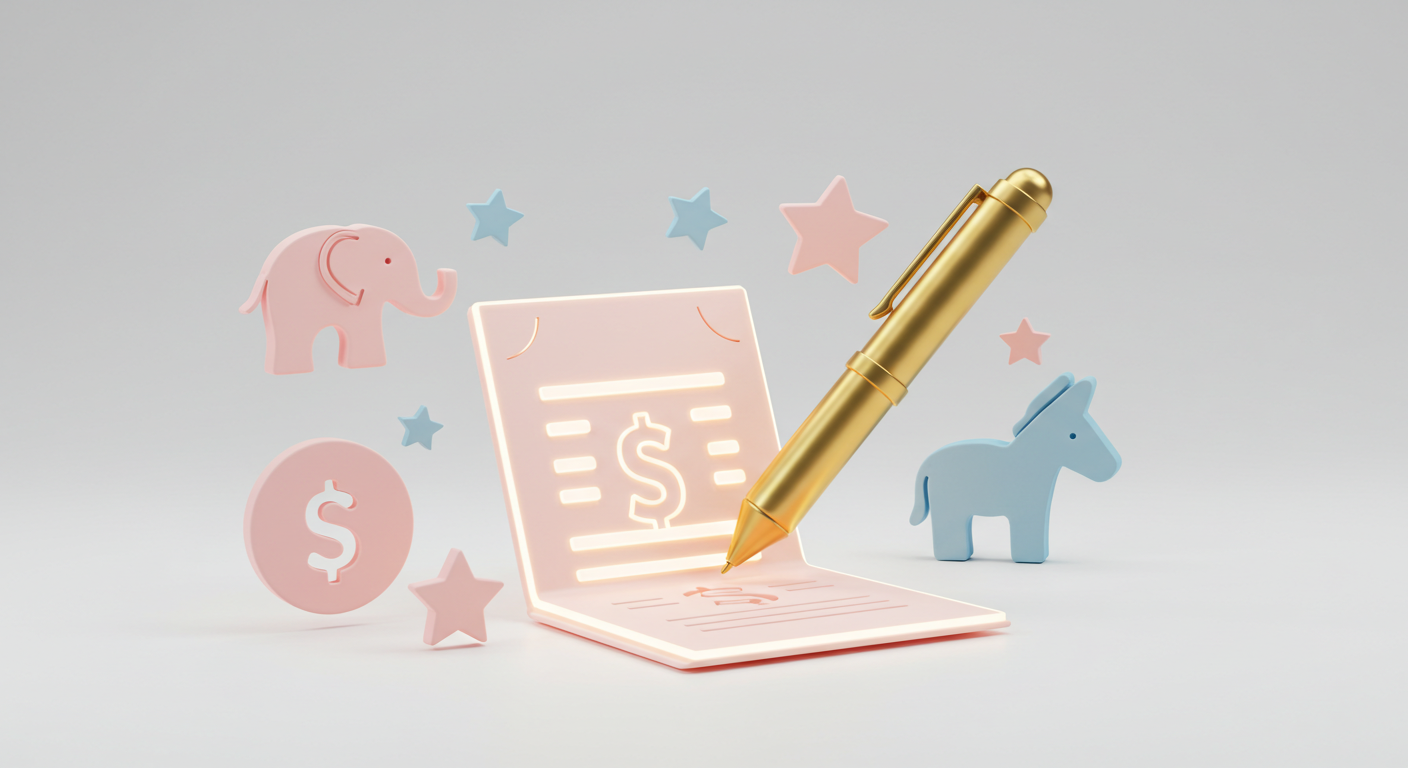
It’s being called the ‘One Big Beautiful Bill Act’—a name as audacious as its plan to permanently rewrite American economic policy. But what’s really inside?
The cornerstone of the OBBBA is its proposal to make the individual tax cuts from the 2017 Tax Cuts and Jobs Act (TCJA) permanent. Proponents, such as the Tax Foundation, argue that such a move could lead to long-term economic growth, projecting a 1.1% increase in the Gross Domestic Product (GDP) over the long run.
They also estimate the creation of approximately 847,000 full-time equivalent jobs. However, the fiscal implications are substantial, with the same analysis indicating a potential $4.5 trillion decrease in federal tax revenue from 2025 to 2034, which could significantly increase the national debt.
The bill’s enactment may be polarising in political circles, but in the markets, it offers something far more valuable—clarity. And for traders, clarity is opportunity
Track Record
Let’s take a step back and consider what resulted from the original Tax Cuts and Jobs Act of 2017 (TCJA).
Trump’s flagship legislation pushed aside the usual slow-drip policymaking and throws open the throttle. At the heart of the TCJA was a historic and permanent reduction in the corporate tax rate from 35% to 21%, a move intended to make the U.S. a more attractive destination for business investment.
Proponents had argued this would unleash a wave of domestic investment and job creation. Indeed, some studies, such as one from the National Bureau of Economic Research, found that the TCJA boosted domestic investment by about 20% for the average firm in the short term.
While the U.S. experienced a bump in GDP growth in the year following the tax cuts, with a rise from 2.4% in 2017 to 2.9% in 2018, the long-term effects are less clear. The Congressional Budget Office (CBO) initially projected the TCJA would add approximately $1.5 trillion to the national debt over a decade.
Decode, Don’t Debate
Every major fiscal event divides opinion. But successful traders don’t waste time arguing ideology. They read between the lines, anticipate sentiment, and position accordingly.
The OBBBA isn’t subtle. It’s designed to drive liquidity back into households and corporations while stripping down social programmes and realigning government spending toward border security, military infrastructure, and domestic investment.
The bill’s primary mechanism for increasing liquidity is a broad package of tax cuts aimed at both individuals and businesses. The total value of these cuts is estimated to reduce federal revenue by approximately $3.4 trillion over the next decade, according to the Congressional Budget Office (CBO).
There will also be a permanent extension of TCJA cuts. These individual tax cuts, which were set to expire on December 31st this year, would be made permanent. This includes maintaining the lower income tax brackets and the increased standard deduction.
Whether this will be successful or not is up for debate, but traders aren’t waiting to see how it pans out.
Equities have already priced in the early effects: defence stocks are up nearly 8% month-over-month, while select industrial ETFs have broken through year-to-date highs.
Risk assets are moving in real time, and if you’re not reading the tape, you’re behind it.
Stimulus Without the Branding
There’s no cheque in the mail, no pandemic-era slogans. But make no mistake—this bill is stimulus in disguise. Not the kind that hands out money, but the kind that recalibrates incentives.
The legislation makes permanent several provisions from the 2017 Trump tax reforms, while introducing new deductions for overtime, tips, family savings, and senior care.
According to the Joint Committee on Taxation, the average working household could see a 3–5% increase in post-tax income, especially in lower tax brackets.
And in the short term, that’s bullish. Consumer-facing sectors may see a bump as households feel the benefit of loosened fiscal policy. Industries like retail, hospitality, and small business services are poised to ride a wave of renewed demand.
Financial institutions, too, may see a rebound in lending activity as confidence returns. For now, this is a consumer-led rally—until inflation or macro tightening begins to push back. That’s where traders earn their edge: riding the trend before it bends.
A New Map for Capital
The OBBBA doesn’t just shift sentiment, it redrafts the investment landscape. This is where sector rotation becomes more than just a technical buzzword. The bill directly reshapes who gets funding and who gets left behind.
Subsidies for green energy and ESG-led projects are being rolled back or capped, with the White House projecting a 60% reduction in clean-energy tax credits over the next five years.
Simultaneously, border infrastructure funding has surged by $175 billion, and defence spending is slated to rise by $220 billion over the next two fiscal years—marking one of the largest peacetime increases in modern history.
Traders must now account for fiscal gravity: where the money is flowing, which sectors are structurally supported, and which ones are now fighting uphill.
The Trader’s Lifestyle Is the New Normal
If there’s one philosophical thread that runs through the OBBBA, it’s this: responsibility is shifting. The state is stepping back. The individual is stepping forward. In policy terms, that means fewer safety nets. In market terms, it means more risk, more reward—and less room for passivity.
This mirrors what traders already live by. There are no guarantees on the charts. Just setups, probabilities, and execution. You eat what you trade.
The OBBBA doesn’t just reflect a change in policy, it reflects a cultural turn toward the very mindset traders already operate with: performance-based outcomes, strategic risk-taking, and constant adaptation.
So while others brace for the impact, traders are already at the wheel, recalibrating their approach and scanning for the next asymmetrical play.
Risk, Reward, and the Window of Opportunity
Moody’s has already revised its U.S. fiscal outlook to “negative,” citing structural deficits. Analysts warn that the total cost of the bill could balloon to $4.1 trillion once interest payments on new debt are factored in. Bond markets have begun to price in higher inflation expectations for late 2025, with 10-year yields creeping back above 4.6%, up from 4.2% just weeks earlier.
But this is where experienced traders shine.
You don’t need to marry the trade—you just need to ride the wave. That could mean rotating into commodities as a hedge against inflation. It could mean scalping defence earnings upside or catching a breakout in overlooked value stocks. The opportunities are there. The volatility is there. The liquidity is waking up. What matters now is how fast you’re moving.
This is the kind of market where nimbleness wins. Not by clinging to convictions, but by responding to signals. When the dust settles, some positions will be crowded. Others overlooked. The advantage will belong to those who acted early and managed risk with discipline.
Built for Winners
There’s no question that the One Big Beautiful Bill is a bold play. It’s built for momentum, not moderation. And in that sense, it shares DNA with the trader’s world. It rewards those who move with conviction, adapt quickly, and execute without hesitation.
At VT Markets, we believe in seizing those moments. We don’t wait for headlines to settle. We read what they mean. We don’t trade on opinion, we trade on outcome. And in a world reshaped by the OBBBA, that mindset isn’t just useful, it’s necessary.
So if you’re watching the markets shift, waiting to decide where you stand—don’t.
Be first. Be fast. Be built for it.









